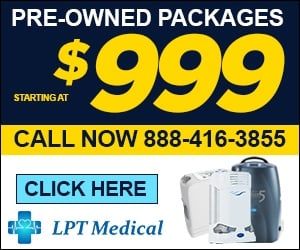
If you are new to the world of oxygen equipment this article is a great place to start. If you are an experienced oxygen user but have been thinking about changing your oxygen device, this is also a great article for you!
Oxygen therapy has been used to treat respiratory illnesses such as pneumonia as early as 1885. Fast forward to 1970, industrial gas suppliers were delivering oxygen tanks and cylinders to oxygen users, and later in the 1970’s, home oxygen concentrators were developed. Concentrators were designed to pull air from the surrounding areas so the oxygen user did not have to re-fill their tanks, so while this was a step in the right direction, both of these methods of oxygen therapy posed an important issue: lack of mobility.

It was only in 2013 when a more portable and efficient form of oxygen therapy was developed and readily available, called portable oxygen concentrators. These devices have the mobility of oxygen canisters, but never need to be refilled similar to a home oxygen concentrator.
Many oxygen users have the option: They can choose between a traditional oxygen tanks or a modern portable oxygen concentrator (POC). If they decide to go with a POC, subsequent decisions about which brand, make, and model they want to go with must be made. Which is where LPT medical comes in.

LPT Medical became one of the most reputable oxygen supply companies in Boca Raton, FL, Denver, CO, and now nationwide because we carry the most efficient and affordable oxygen equipment on the market.
Since 2013, there have been model after model, and new manufacturers popping up, selling portable oxygen devices, so the market has become saturated with "top of the line" equipment, making it difficult and overwhelming for the everyday oxygen patient to find the right device for their needs. Shopping for a portable oxygen concentrator is not for the faint of heart, it is a tedious task and something that takes up a lot of time and research.
This article is square one. We will tell you what factors to look for while shopping for a portable oxygen concentrator; things like battery life, weight, and flow settings are 3 of the most important factors to understand, and beyond that you should also take into consideration the sound level, if it is CPAP and biPAP compatible, if there is a warranty, and how you will afford a new or used POC.
The 3 most important factors to look out for when shopping for a POC

Battery Life
Battery life is probably one of the most important factors you should consider while shopping for a POC, after all, this is one of the main components that will influence oxygen users to ultimately decide on switching from traditional forms of oxygen therapy like an oxygen tank or canister.
Having an oxygen device that runs off of batteries and never runs out of oxygen is the ultimate freedom! Freedom from dealing with oxygen re-supply companies every week, and freedom from the fear of running out of oxygen should you leave the house with a small canister of oxygen for over a few hours.

So the next step is choosing an oxygen device with battery life that will fit into your daily schedule. For instance, if you work from home, or if you spend a lot of time at home, there is no reason for you to spend extra money on a double battery when you have the option to get a device with a single battery. On the other hand, if you like to travel, have a high oxygen output prescription, or enjoy exercising, opting for a double battery device is going to be worth the extra money spent.
These are the kind of questions our respiratory specialist in Denver, Colorado and our other respiratory specialist in Boca Raton, Florida will ask you over the phone in order to help us determine which POC they should recommend for, not only your oxygen prescription but also your lifestyle.

Depending on the brand, make, and model of your portable oxygen concentrator, the batteries will drain energy differently. For example: A reliable model like the Inogen One G4 Portable Concentrator offers two different battery types, 8 cell and 16 cell also known as a single or a double battery, to meet your different oxygen supply requirements.
One thing you should keep in mind, is that the life of your POC all depends on your oxygen prescription, so how much oxygen you need per minute and therefore the setting your POC is set to. For example, if you need a high oxygen output, and your POC is set to level 4 out of 6, the battery will drain faster than if it were set to level 2 out of 6.
Pulse dose concentrators deliver oxygen only when you inhale, and so they stop when you exhale. This pause during your exhale is essentially a break for you POC, and the reduced demand for power saves energy from the battery as compared to a continuous flow mode concentrator. Continuous flow oxygen concentrators is exactly what it sounds like; they offer a constant flow of oxygen regardless of when you inhale or exhale. Because the oxygen device never gets a “break” and it is continually flowing, this type of POC will require more battery power, and they are notably heavier devices.

This brings us into the next section about the flow settings of you POC
Flow settings: continuous and pulse dose
Flow setting is the most obvious factor that will go into your decision while shopping for a POC. But it is also the easiest to narrow down, and not totally in your control.
Your pulmonary physician or you doctor will prescribe you a dosage of oxygen per minute and this is required to buy a portable oxygen concentrators from a licensed distributor. It is then the oxygen supply company’s job to adhere to the prescription and ensure you will be capable of fulfilling your prescription using the POC we recommend to you. Therefore the “flow settings” is not something you get to decide on, but it is something you should know and be fully aware of, because it can change.
COPD is a progressive disease, meaning it gets worse over time. So, if you ever feel short of breath or notice that your COPD symptoms are worsening and you are taking you oxygen therapy as it is prescribed, you should go and see you doctor and see if you need to change your oxygen prescription.
There are POCs that allow you to switch from pulse flow settings to continuously flow settings, like the Respironics SimplyGo. The SimplyGo is the very lightest continuous flow POC on the market, and its battery can actually outlast a lot of other reputable machines out there. This is because it can operate while using one or two batteries. One battery will be perfect for things like exercising, running quick errands, and doing things around your home, while using two batteries is ideal for traveling, road trips, and extended trips away from your home!

Weight
How much a device weighs is the other important factor that you should consider when purchasing a portable oxygen concentrator. Most of the time, people are looking for the most lightweight design, and in this case we suggest looking at the Caire Freestyle Comfort (5 pounds), or the Inogen One G5 (4.7 pounds), or the Respironics SimplyGo Mini Portable Oxygen Concentrator (5 pounds). And while the Inogen One G4 (2.8 pounds) is even lighter, the One G5 and Freestyle Comfort are powerful enough to accommodate mostly every oxygen patient with pulse dose oxygen needs, whereas the One G4 covers a few oxygen patients with a specific oxygen prescription.
And while there are devices that are powerful and lightweight, some people’s oxygen needs a greater than what these particular machines are capable of.
If this is you, you should not shy away from the “heavier” POCs because even though they are not extremely lightweight, they are designed to be portable and easy to maneuver, unlike the restrictive nature of even the lightest weight oxygen tank. For instance, the SeQual Eclipse 5 Portable Oxygen Concentrator is 18.4 pounds.

This is a continuous flow POC, and the SeQual Eclipse 5 is one of the most, if not the most, popular continuous flow portable oxygen concentrators on the market. It has a notable long-standing track record for being durable and reliable because it was designed and approved by the U.S. Military.
So even though the Eclipse is heavier than the pulse flow concentrators, standing 19.3” H x 12.3” W x 7.1” L, the SeQual Eclipse 5 is still easy to travel with, easily fitting underneath the seat in front of you! It comes with a wheeled travel cart that makes pulling your concentrator behind you seem effortless.
The travel cart is equipped with oversized wheels, an elevated platform, and a telescopic handle. The oversized wheels and elevated platform make going up curbs and stairs a breeze. They also help protect your concentrator from water when you have to go over puddles or if you live in Denver, Colorado and you have to worry about walking through snow in October through May.
The Respironics SimplyGo is the lightest continuous flow POC on the market, and it only weighs 10 pounds. This device comes with a carrying cart, or a strap to carry it over your shoulder, but 10 pounds tend to be too heavy to carry in that way. Most folks would opt for the cart to pull behind them.
Other factors
Sound level
The noise you POC makes is a personal preference, and something you should consider if noise tends to bother you. Newer models and pulse flow devices tend to be quieter because of the more modern technology available and the pulse flow machines do not need to be as powerful as a continuous flow device.

Some devices make noises similar to a fan or running water, it is a constant noise that some people would consider “white noise” and can even be relaxing, and can notably reduce anxiety. There are times where customers reach out to us and let us know that their device is making an obvious clicking noise from time to time. Most people will reach out because they are worried their POC is broken, but it is actually perfectly normal. And because the clicking noise is not constant most people do not pay any mind to this once they know it is not an issue with their POC.
Some devices are quieter than others, so if noise is a component of your priorities that you want to take into account when shopping for a POC, be sure to let your respiratory specialist know this when you speak with them over the phone at 1-(800)-946-1201. They will have a list of recommendations that they will be able to narrow down knowing how much you value silence or vise versa.
CPAP and BiPAP compatibility

Every device that we sell is CPAP and BiPAP compatible. However whether or not you should use your POC at night should be discussed in depth with your doctor and it will be a part of your oxygen prescription. So depending on the hours per day you need oxygen, and the flow setting at which it needs to be administered throughout the day and night, will greatly influence which device we end up selling you.
If you have sleep apnea and you need a CPAP or BiPAP device while you sleep, you may also need oxygen as well. This is important for us to know beforehand, because if you are intending on using your POC while you sleep, then we must be sure that it has the capabilities of administering the oxygen you need while you sleep and not just the oxygen you need during the day.
Sleeping with oxygen can be challenging to get used, both at night and even resting throughout the day. We wrote a blog post recently about the challenges of sleeping while using oxygen and how you can overcome them and get back to a regular sleep schedule.
Click here to read The Complete Guide to Sleeping With Supplemental Oxygen
Warranty
If you are buying something new, it is always smart to go with the company that will give you a warranty. Warranty will cover expenses associated with the device should anything malfunction. At LPT Medical, we cover every new device that we sell for 3 years, and we even warranty our used machines on a case by case basis.
Affording a new or used POC

Many people will shy away from shopping for portable oxygen concentrators because they will see on google that the prices can range from $1,000 to $3,000, so without contacting anyone about these prices, they dismiss the idea of ever owning their own POC. The simple truth is that our devices never cost as much as they are being advertised online, but we are obligated to post certain prices online that align with our manufacturer’s policies. In order to speak with a respiratory specialist about the real prices for the POC you're interested in, just call us at 1-(800)-946-1201.
So not only are you not able to see the promotional deals online, but we offer a lot of alternatives would allow you to have your own POC without breaking the bank. We are able to offer you a payment plan in order t pay for your POC, we will set this up together so you do not have to pay a large sum up front. You also have the option to buy a used and refurbished unit that will be a lot less expensive than a brand new unit.
Still on the fence?
It is understandable to be unsure about whether a POC is the best option for you. The bottom line is that even if you like to stay at home most of the day or be active as much as possible, modern oxygen therapy technology will offer benefits in many facets of your life, and this is something you should seriously consider.
Technology is constantly updating with expectations to make people’s lives easier. So if you have a serious pulmonary disease, having the most modern oxygen therapy equipment is the one of the best ways to treat your disease, and the easier you can do that, the better.
The most important aspect of oxygen therapy you do not want to have to worry about, is running low on oxygen. With a POC you will never have to worry about that, because the device extracts the surrounding air and compresses it into medical grade oxygen.
POCs nowadays are designed to be portable, no matter your flow setting. Even if you need a larger device in order to provide the oxygen you need, they are easy to maneuver. Every year, our manufactures are working on new designs, with the intentions of making the most portable lightweight oxygen device that is powerful enough to meet any oxygen users' needs. Which is one of the reasons we offer a buyback program. You are able to sell your device back to us if you become interested in a different unit in the future.
We work with every customer on a case by case basis, so if you are unsure about whether or not you want to buy a portable oxygen concentrator the best way to make the decision is to reach out to us so we can help determine if a POC is right for you and your lifestyle, and how we can work with you to afford it.
Please leave a comment or email us at info@LPTmedical.com and we will gladly connect you with someone to answer any and all of your questions.


.png)






